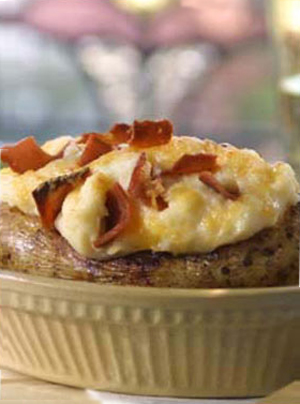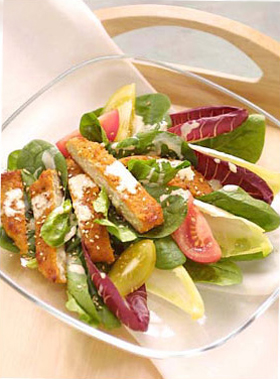 |
 |
If you don’t eat pork products, or are trying to cut down on the cholesterol, enjoy your BLT or bacon-garnished baked potato with Lightlife’s Smart Bacon. Photography courtesy Lightlife.
|
| WHAT IT IS: A delicious line of popular products made with tempeh soy protein instead of animal meat. |
| WHY IT’S DIFFERENT: The texture is so good, and the seasoning so deft, that you don’t realize the “chicken,” “bacon,” “burgers” and so forth are not real meat. |
WHY WE LOVE IT: Another delicious way to cut back on cholesterol and eat sustainably. |
| WHERE TO BUY IT: Find a store locator on the company website, Lightlife.com. |
|
|
 |
 Page 3: What Is Tempeh? Page 3: What Is Tempeh?
Tempeh, Tofu & Seitan: The Big 3 Meat
Substitutes
Unless you eat these foods regularly, it may be difficult to remember the differences. Tofu and tempeh are soy-based, while seitan is wheat-based.
All three are very versatile and easy to cook with. They can be baked, broiled, fried, deep-fried, sautéed, sliced and grated. They can be eaten plain or with condiments. You can use them instead of meat or other protein in chili, salads, sandwiches, soups, stews, stir frys and tacos—and just about any savory preparation. Tofu lends itself to dessert recipes as well.
As with meat, marinating before cooking enhances the flavor. Make an easy marinade from olive oil and balsamic or red wine vinegar. Add lemon juice, soy sauce and other seasonings: herbs, fresh-grated ginger root, garlic, hot sauce, Colman’s mustard or other favorite seasonings.
If you decide to cook your own instead of purchasing ready-to-eat products like Lightlife’s, pick up a good cookbook on the topic.
Tofu
Tofu, or bean curd, is made made from coagulated soy milk. The resulting curds are pressed into blocks. It originated in China about 2000 years ago.
By itself, tofu is mild/bland in flavor, but it easily absorbs seasonings and the flavors of other foods cooked with it. It is made in three levels of firmness:
- Extra-firm tofu, which holds its shape when cooked: use in baked, fried, grilled and sautéed recipes; also great in sandwiches, stir-fries.
- Firm tofu, which can be scrambled like eggs.
- Silken tofu, which can be made into smoothies, dips and desserts, from pudding and pie to frozen desserts like Tofutti.
Tofu Nutrition: One-half cup (4 ounces) of tofu has 88 calories, 5 grams of fat, 10 grams of protein and 0 grams of fiber.
Continue below with tempeh and seitan.
|
INDEX OF REVIEW
This is Page 3 of a three-page review. Click on the black links to visit related pages:
|
MORE TO DISCOVER
|
Tempeh or Tempe
Tempeh is made from fermented whole soy beans. The fermentation gives it a slightly nutty, meaty flavor (some find it mushroomy), compared to bland tofu. Its firm texture is similar to meat.
Tempeh has a great hearty texture. It crisps up well when you fry it, and gets tender and juicy when you bake it. Tempeh has a taste and body all its own.
With the appropriate seasonings, it becomes an excellent substitute for bacon, pepperoni, sausage and other meats. We actually prefer tempeh pastrami to the real thing—all the spice and chewiness of pastrami without the cholesterol and grease.
Tempeh Nutrition: 1/2 cup (4 ounces) of tempeh has 283 calories; 116 calories from fat; 41 grams of protein and 0 grams of fiber.
|
|
 Strips of chick’n, as soy-based chicken is known. Delicious! Strips of chick’n, as soy-based chicken is known. Delicious! |
Seitan
Seitan was first made in China by Zen Buddhists, about 1,000 years ago. It is made from wheat gluten—in fact, it is called wheat gluten, or simply gluten. Mock duck and wheat meat are two more colorful names that address the “meatiness” of the product, which is the meatiest of the vegetarian proteins.
Wheat gluten is the protein portion of wheat—what remains when the bran and starch have been removed. Chewy, juicy—it’s a great meat substitute. In fact, you might not notice that it isn’t meat.
Seitan Nutrition. A 1/3 cup of seitan has 160 calories, .5 gram of fat, 23 grams of protein and 2 grams of fiber. This stuff is hearty, stick to your ribs goodness. It is so versatile and so easy to deal with.
We’ll round out this discussion with two other types of vegetable protein:
Lentils
These tiny legumes are nutritional powerhouses, loaded with protein, minerals and B vitamins and very low in fat. While lentils are excellent in curries, salads, soups and stews, they can also be formed into meaty patties and loaves.
Lentil Nutrition. A one-cup serving of lentils contains 230 calories, 18 grams protein and 1 gram fat.
Textured Vegetable Protein (TVP) or Textured Soy Protein (TSP)
A dried soy product that can be used in place of ground beef in stews, chili, tacos, pasta sauce, etc. Another product with a variety of names, TVP is also called soy meat or soya meat. It is used as both a ground meat substitute (in chili, pasta sauce, tacos and veggie burgers, e.g.) and a meat/fish extender (in burgers or tuna salad, for example).
TVP, in the form of dried chunks of soy, is made from defatted soy flour, a by-product of extracting oil from soybeans. It is flavorless right out of the package, but when it is rehydrated and seasoned, it takes on the flavor of the seasoning.
TVP Nutrition. A three-ounce serving contains 240 calories, and 42 grams of protein and almost 0 g fat.
Even died-in-the-wool carnivores can enjoy these vegetarian proteins. They’re:
- Sustainable, conserving the earth
- Cholesterol-free
- Delicious
- Affordable
Give it a try!
—Karen Hochman
Do you have friends who would enjoy THE NIBBLE?
Click here to send them an invitation to sign up for their own copy. |
© Copyright 2004-2025 Lifestyle Direct, Inc. All rights
reserved. All information contained herein is subject to change at any time
without notice. All details must be directly confirmed with manufacturers, service
establishments and other third parties. The material in this e-zine may not
be reproduced, distributed, transmitted, cached, or otherwise used, except with
the prior written permission of Lifestyle Direct, Inc.
|
|

|
 |